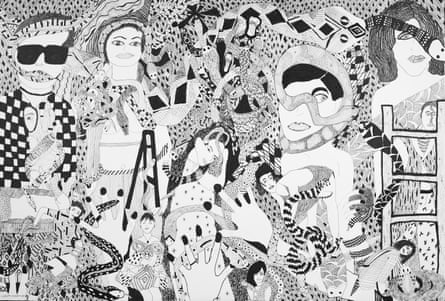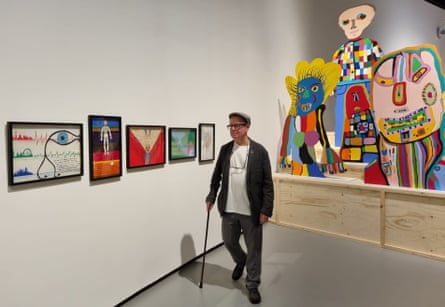Art
differently various review – artists with brain injuries balance anger with joy
Who gets to call themselves an artist? Is it Chippy Aiton and Jon Barry, who need assistance to hold their arms up while painting? Is it Terrance Barr, who is partially blind, feeling his way around clay? Is it people who can create for a maximum of 20 minutes a day, or only those who are able to sit and work for hours?
differently various opens with an interrogation of what defines an artist and who that definition excludes in an industry that is overwhelmingly white, middle-class and non-disabled. The grand finale of a five-year partnership between the Barbican and brain injury charity Headway East London, the exhibition is thought to be the largest ever created by people with a brain injury, displaying 124 works by more than 70 artists.
It isn’t surprising that its participants are asking this question, as the politics around supporting and platforming disabled art can be painstaking. Several accessibility measures have been put into place for this show, such as a temporary ramp at the entrance and communication cards (though there is no Braille nor mention of wearing masks), but they will mostly be gone when differently various finishes.

This calls into question: if many disabled people can’t even enter galleries, how can we be considered to display our works in them? Simply through the privilege of existing in a mainstream space with a ramp, this exhibition feels like a small step forward on a long road towards equity for disabled artists and art fans.
differently various takes the viewer through four journeys: Experience, Learning, Creativity and Community. Initially we are confronted by images evoking a sense of despair, depicting the harsh realities of what it’s like to live in a world hostile to disability and in bodies that don’t perform how they used to. In Mike Hoyle’s installation The Seven Demons of Disability we see colourful plastic spines with skull heads at the top, one of which contains a brain that has been split in two, representing injury. In Billy Mann’s My Stroke, he writes of his debilitating experiences on a collection of five paintings. One piece describes rehab as “maybe it is more than I deserve. Maybe”.
Chris Miller’s painting Me as Venus reimagines Botticelli’s The Birth of Venus with an image of his own body, questioning standards around beauty, perfection and disability. Elsewhere we find Lawrence’s Language, a 15-metre scroll of colourful pencil scribbles and doodles by Lawrence Carroll, whose main method of communication is through blinking.

The artists on display have chosen different media forms – from narrative video to oil paint, pencil, papier-mache and huge, cross-stitched canvases draping the room – to share their stories of how they acquired their brain injuries, personal moments in their rehabilitation journeys, what it has been like moving through the pandemic as a person with a brain injury and what community means to them.
It is at times uncomfortable to read the personal stories scrawled across imagery and in the video content on display. Tales that so viscerally illustrate people coming to terms with loss and grieving the body they used to have, and that so brutally and colourfully depict the imperfect world in which we live. But as you move around the tight curve into the expansive section of the gallery, you are also greeted by joyful art that reimagines and celebrates. Take Tirzah Mileham’s pen and ink drawings When Women and Fish Ruled the World, or the joyful collaborative embroidery and applique Sister Stitch, in which seven artists depict sisterhood and community.
Through differently various, a collective has found a space to express themselves and push boundaries. Their work is sometimes ugly, sometimes beautiful, often both, and in each case prompts a rollercoaster of thought and emotion. Isn’t that the true definition of artistry?

Art
Calvin Lucyshyn: Vancouver Island Art Dealer Faces Fraud Charges After Police Seize Millions in Artwork

In a case that has sent shockwaves through the Vancouver Island art community, a local art dealer has been charged with one count of fraud over $5,000. Calvin Lucyshyn, the former operator of the now-closed Winchester Galleries in Oak Bay, faces the charge after police seized hundreds of artworks, valued in the tens of millions of dollars, from various storage sites in the Greater Victoria area.
Alleged Fraud Scheme
Police allege that Lucyshyn had been taking valuable art from members of the public under the guise of appraising or consigning the pieces for sale, only to cut off all communication with the owners. This investigation began in April 2022, when police received a complaint from an individual who had provided four paintings to Lucyshyn, including three works by renowned British Columbia artist Emily Carr, and had not received any updates on their sale.
Further investigation by the Saanich Police Department revealed that this was not an isolated incident. Detectives found other alleged victims who had similar experiences with Winchester Galleries, leading police to execute search warrants at three separate storage locations across Greater Victoria.
Massive Seizure of Artworks
In what has become one of the largest art fraud investigations in recent Canadian history, authorities seized approximately 1,100 pieces of art, including more than 600 pieces from a storage site in Saanich, over 300 in Langford, and more than 100 in Oak Bay. Some of the more valuable pieces, according to police, were estimated to be worth $85,000 each.
Lucyshyn was arrested on April 21, 2022, but was later released from custody. In May 2024, a fraud charge was formally laid against him.
Artwork Returned, but Some Remain Unclaimed
In a statement released on Monday, the Saanich Police Department confirmed that 1,050 of the seized artworks have been returned to their rightful owners. However, several pieces remain unclaimed, and police continue their efforts to track down the owners of these works.
Court Proceedings Ongoing
The criminal charge against Lucyshyn has not yet been tested in court, and he has publicly stated his intention to defend himself against any pending allegations. His next court appearance is scheduled for September 10, 2024.
Impact on the Local Art Community
The news of Lucyshyn’s alleged fraud has deeply affected Vancouver Island’s art community, particularly collectors, galleries, and artists who may have been impacted by the gallery’s operations. With high-value pieces from artists like Emily Carr involved, the case underscores the vulnerabilities that can exist in art transactions.
For many art collectors, the investigation has raised concerns about the potential for fraud in the art world, particularly when it comes to dealing with private galleries and dealers. The seizure of such a vast collection of artworks has also led to questions about the management and oversight of valuable art pieces, as well as the importance of transparency and trust in the industry.
As the case continues to unfold in court, it will likely serve as a cautionary tale for collectors and galleries alike, highlighting the need for due diligence in the sale and appraisal of high-value artworks.
While much of the seized artwork has been returned, the full scale of the alleged fraud is still being unraveled. Lucyshyn’s upcoming court appearances will be closely watched, not only by the legal community but also by the wider art world, as it navigates the fallout from one of Canada’s most significant art fraud cases in recent memory.
Art collectors and individuals who believe they may have been affected by this case are encouraged to contact the Saanich Police Department to inquire about any unclaimed pieces. Additionally, the case serves as a reminder for anyone involved in high-value art transactions to work with reputable dealers and to keep thorough documentation of all transactions.
As with any investment, whether in art or other ventures, it is crucial to be cautious and informed. Art fraud can devastate personal collections and finances, but by taking steps to verify authenticity, provenance, and the reputation of dealers, collectors can help safeguard their valuable pieces.
Art
Ukrainian sells art in Essex while stuck in a warzone – BBC.com
[unable to retrieve full-text content]
Ukrainian sells art in Essex while stuck in a warzone BBC.com

Source link
Art
Somerset House Fire: Courtauld Gallery Reopens, Rest of Landmark Closed
The Courtauld Gallery at Somerset House has reopened its doors to the public after a fire swept through the historic building in central London. While the gallery has resumed operations, the rest of the iconic site remains closed “until further notice.”
On Saturday, approximately 125 firefighters were called to the scene to battle the blaze, which sent smoke billowing across the city. Fortunately, the fire occurred in a part of the building not housing valuable artworks, and no injuries were reported. Authorities are still investigating the cause of the fire.
Despite the disruption, art lovers queued outside the gallery before it reopened at 10:00 BST on Sunday. One visitor expressed his relief, saying, “I was sad to see the fire, but I’m relieved the art is safe.”
The Clark family, visiting London from Washington state, USA, had a unique perspective on the incident. While sightseeing on the London Eye, they watched as firefighters tackled the flames. Paul Clark, accompanied by his wife Jiorgia and their four children, shared their concern for the safety of the artwork inside Somerset House. “It was sad to see,” Mr. Clark told the BBC. As a fan of Vincent Van Gogh, he was particularly relieved to learn that the painter’s famous Self-Portrait with Bandaged Ear had not been affected by the fire.
Blaze in the West Wing
The fire broke out around midday on Saturday in the west wing of Somerset House, a section of the building primarily used for offices and storage. Jonathan Reekie, director of Somerset House Trust, assured the public that “no valuable artefacts or artworks” were located in that part of the building. By Sunday, fire engines were still stationed outside as investigations into the fire’s origin continued.
About Somerset House
Located on the Strand in central London, Somerset House is a prominent arts venue with a rich history dating back to the Georgian era. Built on the site of a former Tudor palace, the complex is known for its iconic courtyard and is home to the Courtauld Gallery. The gallery houses a prestigious collection from the Samuel Courtauld Trust, showcasing masterpieces from the Middle Ages to the 20th century. Among the notable works are pieces by impressionist legends such as Edouard Manet, Claude Monet, Paul Cézanne, and Vincent Van Gogh.
Somerset House regularly hosts cultural exhibitions and public events, including its popular winter ice skating sessions in the courtyard. However, for now, the venue remains partially closed as authorities ensure the safety of the site following the fire.
Art lovers and the Somerset House community can take solace in knowing that the invaluable collection remains unharmed, and the Courtauld Gallery continues to welcome visitors, offering a reprieve amid the disruption.
-

 Sports18 hours ago
Sports18 hours agoCavaliers and free agent forward Isaac Okoro agree to 3-year, $38 million deal, AP source says
-

 Sports18 hours ago
Sports18 hours agoLiverpool ‘not good enough’ says Arne Slot after shock loss against Nottingham Forest
-

 News18 hours ago
News18 hours agok.d. lang gets the band back together for Canadian country music awards show
-

 Sports3 hours ago
Sports3 hours agoArmstrong scores, surging Vancouver Whitecaps beat slumping San Jose Earthquakes 2-0
-

 News18 hours ago
News18 hours agoNATO military committee chair, others back Ukraine’s use of long range weapons to hit Russia
-

 News18 hours ago
News18 hours agoWith a parade of athletes on Champs Elysées, France throws one last party for the Paris Olympics
-

 News19 hours ago
News19 hours ago‘Challenges every single muscle’: Champion tree climber turns work into passion
-

 News3 hours ago
News3 hours agoAs plant-based milk becomes more popular, brands look for new ways to compete



















